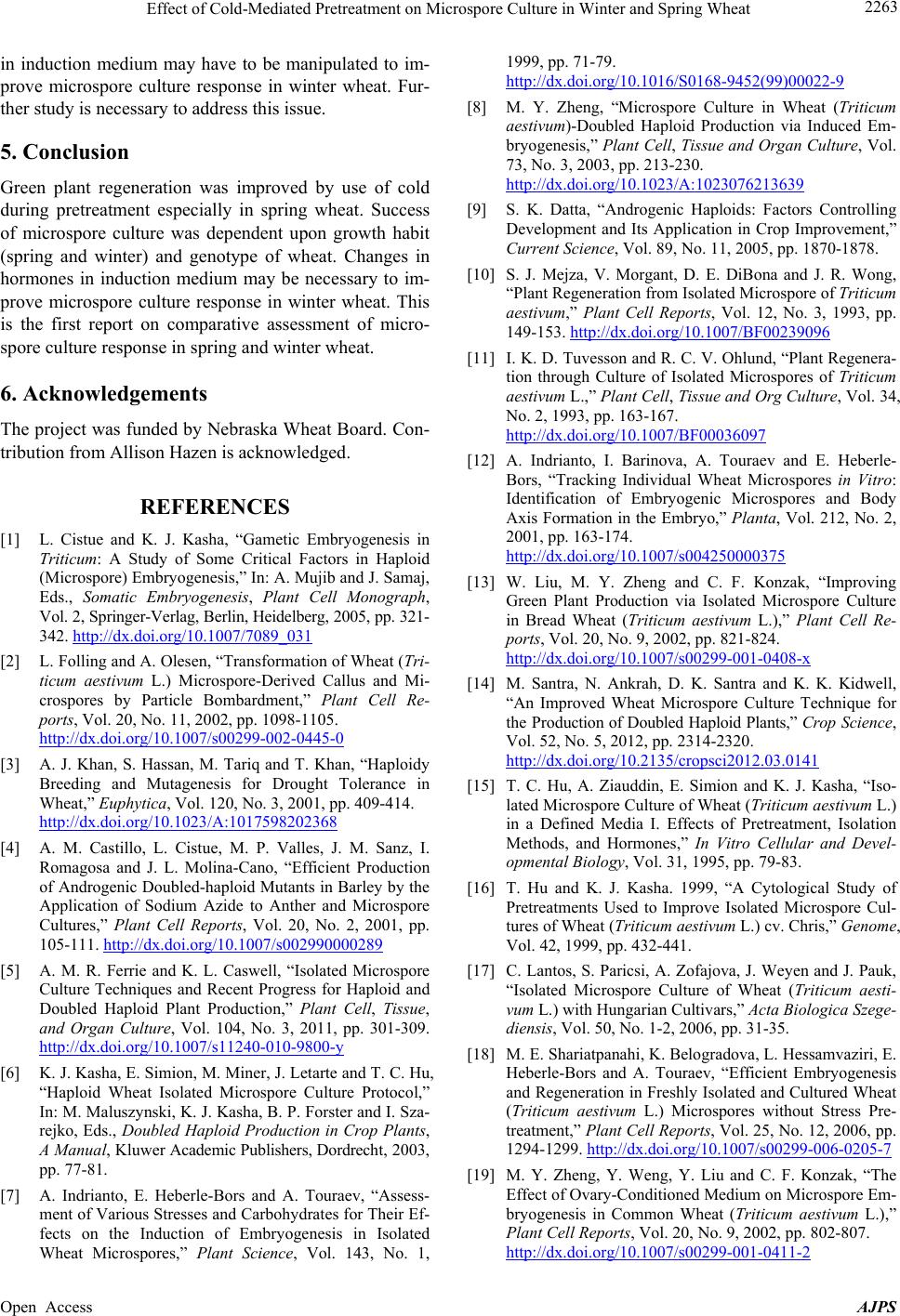
Effect of Cold-Mediated Pretreatment on Microspore Culture in Winter and Spring Wheat 2263
in induction medium may have to be manipulated to im-
prove microspore culture response in winter wheat. Fur-
ther study is necessary to address this issue.
5. Conclusion
Green plant regeneration was improved by use of cold
during pretreatment especially in spring wheat. Success
of microspore culture was dependent upon growth habit
(spring and winter) and genotype of wheat. Changes in
hormones in induction medium may be necessary to im-
prove microspore culture response in winter wheat. This
is the first report on comparative assessment of micro-
spore culture response in spring and winter wheat.
6. Acknowledgements
The project was funded by Nebraska Wheat Board. Con-
tribution from Allison Hazen is acknowledged.
REFERENCES
[1] L. Cistue and K. J. Kasha, “Gametic Embryogenesis in
Triticum: A Study of Some Critical Factors in Haploid
(Microspore) Embryogenesis,” In: A. Mujib and J. Samaj,
Eds., Somatic Embryogenesis, Plant Cell Monograph,
Vol. 2, Springer-Verlag, Berlin, Heidelberg, 2005, pp. 321-
342. http://dx.doi.org/10.1007/7089_031
[2] L. Folling and A. Olesen, “Transformation of Wheat (Tri-
ticum aestivum L.) Microspore-Derived Callus and Mi-
crospores by Particle Bombardment,” Plant Cell Re-
ports, Vol. 20, No. 11, 2002, pp. 1098-1105.
http://dx.doi.org/10.1007/s00299-002-0445-0
[3] A. J. Khan, S. Hassan, M. Tariq and T. Khan, “Haploidy
Breeding and Mutagenesis for Drought Tolerance in
Wheat,” Euphytica, Vol. 120, No. 3, 2001, pp. 409-414.
http://dx.doi.org/10.1023/A:1017598202368
[4] A. M. Castillo, L. Cistue, M. P. Valles, J. M. Sanz, I.
Romagosa and J. L. Molina-Cano, “Efficient Production
of Androgenic Doubled-haploid Mutants in Barley by the
Application of Sodium Azide to Anther and Microspore
Cultures,” Plant Cell Reports, Vol. 20, No. 2, 2001, pp.
105-111. http://dx.doi.org/10.1007/s002990000289
[5] A. M. R. Ferrie and K. L. Caswell, “Isolated Microspore
Culture Techniques and Recent Progress for Haploid and
Doubled Haploid Plant Production,” Plant Cell, Tissue ,
and Organ Culture, Vol. 104, No. 3, 2011, pp. 301-309.
http://dx.doi.org/10.1007/s11240-010-9800-y
[6] K. J. Kasha, E. Simion, M. Miner, J. Letarte and T. C. Hu,
“Haploid Wheat Isolated Microspore Culture Protocol,”
In: M. Maluszynski, K. J. Kasha, B. P. Forster and I. Sza-
rejko, Eds., Doubled Haploid Production in Crop Plants,
A Manual, Kluwer Academic Publishers, Dordrecht, 2003,
pp. 77-81.
[7] A. Indrianto, E. Heberle-Bors and A. Touraev, “Assess-
ment of Various Stresses and Carbohydrates for Their Ef-
fects on the Induction of Embryogenesis in Isolated
Wheat Microspores,” Plant Science, Vol. 143, No. 1,
1999, pp. 71-79.
http://dx.doi.org/10.1016/S0168-9452(99)00022-9
[8] M. Y. Zheng, “Microspore Culture in Wheat (Triticum
aestivum)-Doubled Haploid Production via Induced Em-
bryogenesis,” Plant Cell, Tissue and Organ Culture, Vol.
73, No. 3, 2003, pp. 213-230.
http://dx.doi.org/10.1023/A:1023076213639
[9] S. K. Datta, “Androgenic Haploids: Factors Controlling
Development and Its Application in Crop Improvement,”
Current Science, Vol. 89, No. 11, 2005, pp. 1870-1878.
[10] S. J. Mejza, V. Morgant, D. E. DiBona and J. R. Wong,
“Plant Regeneration from Isolated Microspore of Triticum
aestivum,” Plant Cell Reports, Vol. 12, No. 3, 1993, pp.
149-153. http://dx.doi.org/10.1007/BF00239096
[11] I. K. D. Tuvesson and R. C. V. Ohlund, “Plant Regenera-
tion through Culture of Isolated Microspores of Triticum
aestivum L.,” Plant Cell, Tissue and Org Culture, Vol. 34,
No. 2, 1993, pp. 163-167.
http://dx.doi.org/10.1007/BF00036097
[12] A. Indrianto, I. Barinova, A. Touraev and E. Heberle-
Bors, “Tracking Individual Wheat Microspores in Vitro:
Identification of Embryogenic Microspores and Body
Axis Formation in the Embryo,” Planta, Vol. 212, No. 2,
2001, pp. 163-174.
http://dx.doi.org/10.1007/s004250000375
[13] W. Liu, M. Y. Zheng and C. F. Konzak, “Improving
Green Plant Production via Isolated Microspore Culture
in Bread Wheat (Triticum aestivum L.),” Plant Cell Re-
ports, Vol. 20, No. 9, 2002, pp. 821-824.
http://dx.doi.org/10.1007/s00299-001-0408-x
[14] M. Santra, N. Ankrah, D. K. Santra and K. K. Kidwell,
“An Improved Wheat Microspore Culture Technique for
the Production of Doubled Haploid Plants,” Crop Science,
Vol. 52, No. 5, 2012, pp. 2314-2320.
http://dx.doi.org/10.2135/cropsci2012.03.0141
[15] T. C. Hu, A. Ziauddin, E. Simion and K. J. Kasha, “Iso-
lated Microspore Culture of Wheat (Triticum aestivum L.)
in a Defined Media I. Effects of Pretreatment, Isolation
Methods, and Hormones,” In Vitro Cellular and Devel-
opmental Biology, Vol. 31, 1995, pp. 79-83.
[16] T. Hu and K. J. Kasha. 1999, “A Cytological Study of
Pretreatments Used to Improve Isolated Microspore Cul-
tures of Wheat (Triticum aestivum L.) cv. Chris,” Genome,
Vol. 42, 1999, pp. 432-441.
[17] C. Lantos, S. Paricsi, A. Zofajova, J. Weyen and J. Pauk,
“Isolated Microspore Culture of Wheat (Triticum aesti-
vum L.) with Hungarian Cultivars,” Acta Biologica Szege-
diensis, Vol. 50, No. 1-2, 2006, pp. 31-35.
[18] M. E. Shariatpanahi, K. Belogradova, L. Hessamvaziri, E.
Heberle-Bors and A. Touraev, “Efficient Embryogenesis
and Regeneration in Freshly Isolated and Cultured Wheat
(Triticum aestivum L.) Microspores without Stress Pre-
treatment,” Plant Cell Reports, Vol. 25, No. 12, 2006, pp.
1294-1299. http://dx.doi.org/10.1007/s00299-006-0205-7
[19] M. Y. Zheng, Y. Weng, Y. Liu and C. F. Konzak, “The
Effect of Ovary-Conditioned Medium on Microspore Em-
bryogenesis in Common Wheat (Triticum aestivum L.),”
Plant Cell Reports, Vol. 20, No. 9, 2002, pp. 802-807.
http://dx.doi.org/10.1007/s00299-001-0411-2
Open Access AJPS